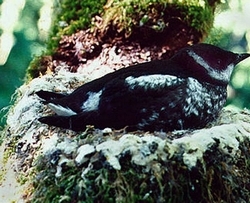forum
library
tutorial
contact

Endangered Bird's Plight Tables Wind Farm;
Demand may Bring it Back
by Editorial Board
The Daily News, December 2, 2011
|
the film forum library tutorial contact |

|
Endangered Bird's Plight Tables Wind Farm;
by Editorial Board
|
 Two years ago, Dean Takko uttered what would prove to be prophetic words.
Two years ago, Dean Takko uttered what would prove to be prophetic words.
Takko, then and now a Democratic state legislator from Longview, called the proposed wind farm on Radar Ridge near Naselle "a great idea." Then he added, "it's got all the good things going for it, except for that little bird."
The little bird, of course, is the marbled murrelet, a threatened species since 1992.
Concerns about the robin-sized bird have been big enough to kill the wind farm project. Two weeks ago, Energy Northwest and four Southwest Washington utilities canceled the Radar Ridge project, which was to include 32 wind turbines and would have been the first major wind farm in the region.
About $4 million had been spent on the proposed project since 2007, but new restrictions proposed by the U.S. Fish and Wildlife Service were unreasonable, according to Energy Northwest.
We sympathize with Energy Northwest's assertion. A draft environmental impact statement by the USFWS called for the Radar Ridge turbines to be shut down six months of the year during daylight hours to protect the bird.
Marbled murrelets nest in old growth trees -- but fly to the ocean to feed on fish. One study on the proposed wind farm concluded that the spinning blades would kill one murrelet per year at most. That seems acceptable, considering that about 18,000 of the birds are thought to exist.
It's not the first time a bird has had a big impact on development in the Northwest. Efforts to project the endangered spotted owl brought reductions in logging of old growth in the 1990s.
It wasn't just about the spotted owl: people who championed the owls also objected to what was widely viewed as rate of logging that couldn't be sustained.
However, wind power should appeal to most Audubon Society types. It's green. It's renewable. It doesn't require drilling for oil or hauling coal on the railroads. Unlike hydroelectric power, wind farms don't harm fish.
Still, the Seattle Audubon Society called the decision to abandon the Radar Ridge project a major victory, suggesting that a better place could be found for wind farms. We aren't holding our breath for the discovery of a perfect site. Proposed turbines in the Columbia River Gorge have been assailed because they'd tarnish the view, in some people's eyes.
Though the marbled murrelet was the main factor that grounded the Radar Range proposal, the crumbling market for wind-generated power and the politics blowing around the issue were likely factors, too.
One reason the Cowlitz PUD's rates went up 18 percent last month is that the utility can't sell as much electricity from its wind farms in Klickitat County as it once did. A California law requires utilities there to buy their wind power from within the Golden State.
Possible changes to Washington's I-937, passed by state voters in 2006, could also have a big effect on the wind power market, too. The voter-approved initiative requires utilities to get 9 percent of their power from "new" sources of renewable energy, such as wind. That percentage is scheduled to increase to 15 percent in 2020. Those seeking change point out the law's logic-defying exclusion of hydro power as "renewable," even though the rain falls as reliably as the wind blows.
Even if I-937 gets changed to add hydro to the renewable list, we expect an eventual increased demand for wind power, even at the expense of a few endangered birds.
learn more on topics covered in the film
see the video
read the script
learn the songs
discussion forum
